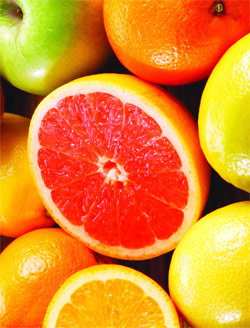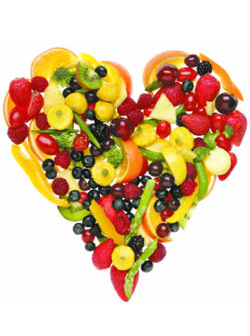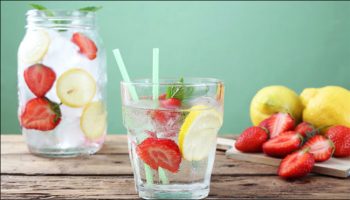In a recent study, researchers have identified a compound found in oranges, grapefruits and other citrus fruits that may lower a woman’s risk of stroke.

Flavonoids have been shown to improve blood vessel function in addition to their myriad and powerful anti-inflammatory benefits.
In the study, conducted at Boston’s Harvard Medical School and Brigham and Women’s Hospital, flavonoids found abundantly in citrus fruits called flavanones appear to give the most protection against stroke. According to the study, which analyzed 14 years of follow-up data on nearly 70,000 female nurses who participated in the nationwide health study, women whose diets included the highest amount of flavanones had a 19 percent lower risk of suffering a blood-related stroke than women with the lowest intake of the compound.
The baseline median intake of total flavonoids (quintile 3) was 232 mg/day while the lowest intake (quintile 1) was 96.8 mg/day and the highest (quintile 5) was 761.2 mg/day (in the study).
Flavonoids: What are they?
 The flavonoids are a diverse group of polyphenolic compounds widely distributed in the plant kingdom. Over 4000 structurally unique flavonoids have been identified in plant sources. These are primarily recognized as the pigments responsible for the many shades of yellow, orange, and red in of flowers, fruit, and leaves. They may be divided into six different major classes (flavonols, flavanones, flavones, isoflavones, flavonols and anthocyanidins ) based on differences in molecular backbone structure. Flavanones are the class of flavonoids found in citrus fruits.
The flavonoids are a diverse group of polyphenolic compounds widely distributed in the plant kingdom. Over 4000 structurally unique flavonoids have been identified in plant sources. These are primarily recognized as the pigments responsible for the many shades of yellow, orange, and red in of flowers, fruit, and leaves. They may be divided into six different major classes (flavonols, flavanones, flavones, isoflavones, flavonols and anthocyanidins ) based on differences in molecular backbone structure. Flavanones are the class of flavonoids found in citrus fruits.
Talking about their anti-stroke effect, .Flavonoids seems to suppress LDL oxidation and inflammatory progression in the artery wall. A Japanese study reported an inverse correlation between flavonoid intake and total plasma cholesterol concentrations, other clinical studies, as mentioned earlier, stated that flavonoid intakes protect against coronary heart disease. Atherosclerosis is a condition that results from the gradual build-up of fatty substances, including cholesterol, on the walls of the arteries. This build-up, called plaque, reduces the blood flow to the heart, brain and other tissues and can progress to cause a heart attack or stroke. This process is commonly referred to as hardening of the arteries. An elevated plasma low density lipoprotein (LDL) concentration is a primary risk factor for the development of atherosclerosis and coronary artery disease. Reactive oxygen species generated through lipid peroxidation can oxidatively modify i.e. oxidize the amino acid residues of LDL and this can initiate the atherosclerotic process.
Adding small amounts of oranges, grapefruit’s, lemons and tangerines is a good way to get started and ease your way into it.
Role of Vitamin C
 Vitamin C is found abundantly in citrus fruits. Research indicates that a majority of patients with heart disease (70-80%) exhibit very low blood levels of vitamin C. A study published in the British medical journal Lancet provides evidence that vitamin C intake increases lifespan by reducing the chances of dying from cardiovascular disease. Furthermore, vitamin C is necessary for bone maintenance, especially since collagen forms the structural framework of bones.
Vitamin C is found abundantly in citrus fruits. Research indicates that a majority of patients with heart disease (70-80%) exhibit very low blood levels of vitamin C. A study published in the British medical journal Lancet provides evidence that vitamin C intake increases lifespan by reducing the chances of dying from cardiovascular disease. Furthermore, vitamin C is necessary for bone maintenance, especially since collagen forms the structural framework of bones.
Like all other cells in the body, the artery cells are constantly under attack from free radicals and other cell-damaging forces and are in a continual state or replacement and repair. As a consequence, they need a constant supply of new collagen to replace the damaged cells. Collagen is, itself, constructed of a number of components, including Vitamin C.
When there is insufficient Vitamin C in the body, new collagen cannot be formed to repair the damaged artery cells. this causes a problem for the body, which does not plan for future problems, but is only interested is surviving the “here and now”. It therefore has to find something else to repair the damage and uses what could be referred to as the body’s “band-aid”, namely cholesterol. Molecules of cholesterol actually bind to the damaged sites, preventing blood loss and its disastrous consequences.
Recent study has shown that high intakes of vitamin C (500 mg/day) obtained from the juice of freshly squeezed oranges, prevented a rise in the levels of oxidized LDL, even in the presence of a high-saturated fat diet (Harats et al., 1998). |
Inadequate intake of Vitamin C & cholesterol bandage leads to gradual clogging of arteries, restricting the blood flow, causing ischemia (lack of blood flow) and infarction (cell-death due to oxygen “starvation”) heart disease.
However, women need to be mindful before digging into a juicy grapefruit or downing a big glass of grapefruit juice, which can sometimes cause dangerous interactions with medication commonly prescribed to lower heart attack and stroke risk.
Added Benefits
 Citrus fruits contain many vitamins and minerals that are essential for the health and well-being of your body. Vitamins such as B1 and B6, as well as calcium, potassium, folate, niacin, phosphorus, magnesium, copper, riboflavin, pantothenic acid and a variety of phytochemicals.
Citrus fruits contain many vitamins and minerals that are essential for the health and well-being of your body. Vitamins such as B1 and B6, as well as calcium, potassium, folate, niacin, phosphorus, magnesium, copper, riboflavin, pantothenic acid and a variety of phytochemicals.
A low dietary intake of folate contributes to the decrease of plasma folate and the raising of plasma homocysteine levels (Bloom, 1998; Tucker et al., 1996). Homocysteineis a toxic agent for the vascular wall and, when plasma levels rise above normal, there is an increased risk of cardiovascular disease. An inverse dose-response relationship has been identified for fruit and vegetable intake and plasma homocysteine levels. Frequent consumption of folate-rich foods, such as oranges and orange juice, tends to increase plasma folate levels and, thus, lower homocysteine levels.
All the citrus fruits are fat free, sodium and cholesterol free. In addition, they are very good sources of dietary fiber. A diet that is fat free and cholesterol free and rich with fiber is always great for the heart health.
At the end of the day, if you are not currently incorporating enough citrus fruits into your diet, then you need to start doing so as quickly as possible so that you can start to feel the benefits.
Nutritional facts about Citrus Fruit
Source: http://www.fao.org |
Additional Links:
Disclaimer
The Content is not intended to be a substitute for professional medical advice, diagnosis, or treatment. Always seek the advice of your physician or other qualified health provider with any questions you may have regarding a medical condition.



